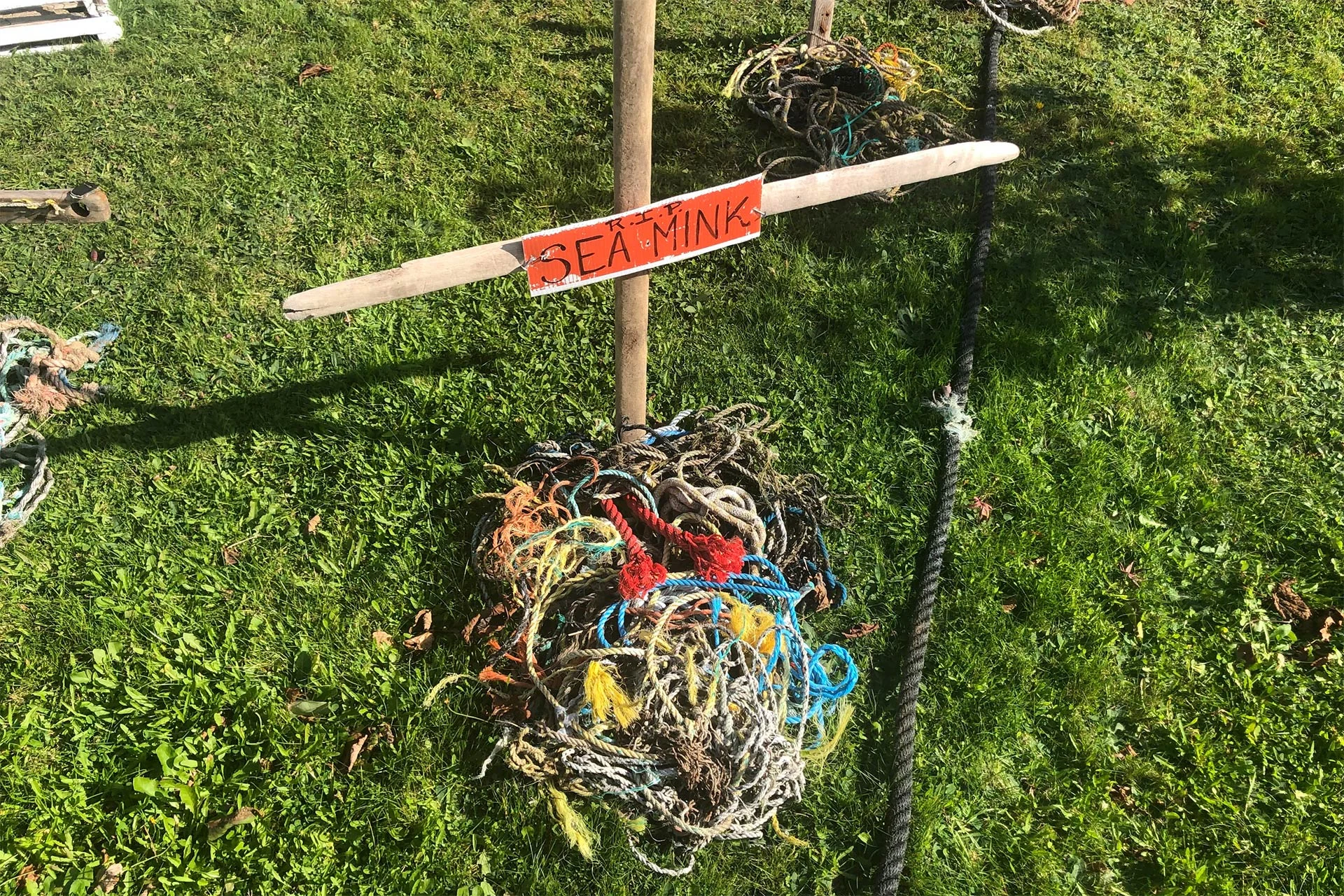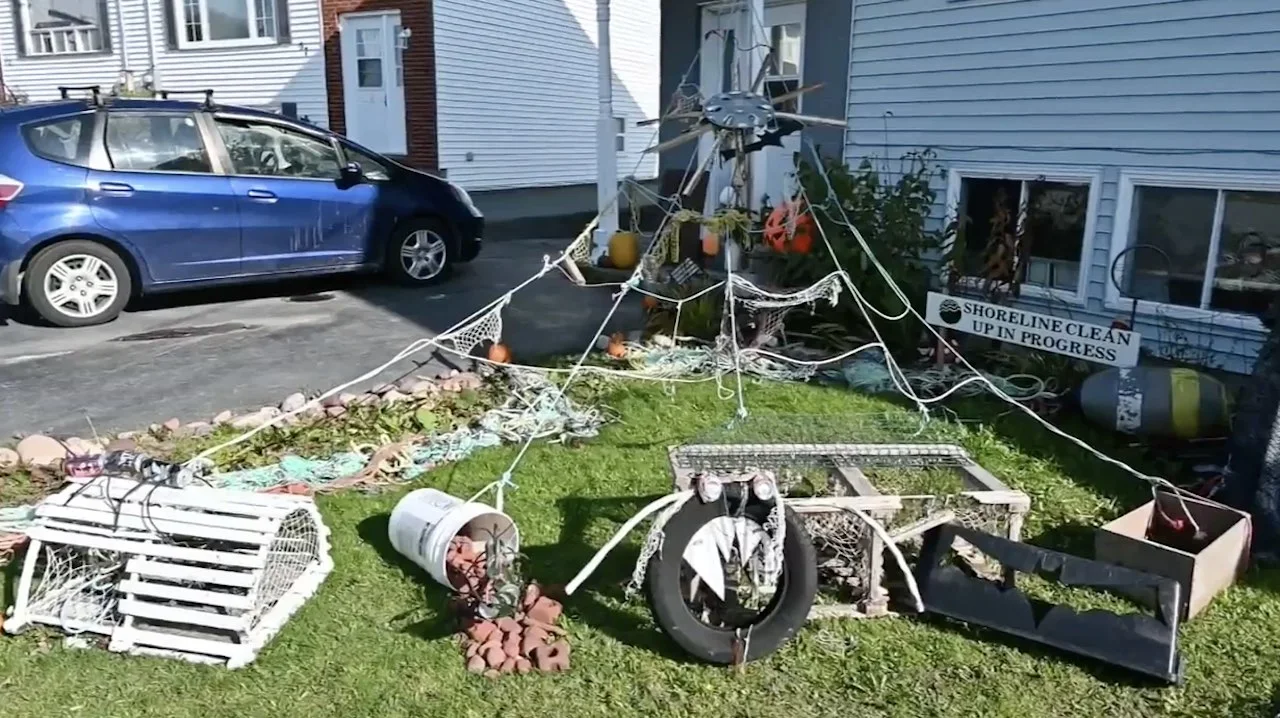
Halloween display highlights scary amount of trash on Nova Scotia shorelines
Forget vampires, witches, werewolves and mummies — the amount of garbage washing up on Nova Scotia's shores is far more terrifying.
Now that spooky season is upon us, a woman has created a Halloween display in the yard of her home in Eastern Passage, N.S. It is made entirely of trash hauled from the province's coastlines in the last month.
SEE ALSO: Millions of tonnes of pumpkins wasted annually: Here's how to reduce waste
Angela Riley, founder of the shoreline cleanup business Scotian Shores, got the idea after seeing someone use a store-bought spider web decoration.
"All I could think was, 'Man, that's just going in the garbage,'" said Riley.
"And that's when it hit me — I was like, 'Oh, maybe I could make a display in my front yard with all the stuff I'm finding on the shorelines.'"
The decorations are made mostly of tires, old rope, cans and lobster traps. The display features grave markers, made from old lobster traps, for sea animals native to Nova Scotia that have gone extinct.
They include the great auk and the sea mink, which were hunted to extinction in the 19th century, as well as the Labrador duck, which died out largely due to food shortages.

Angela Riley, founder of the shoreline cleanup business Scotian Shores, got the idea for the display after seeing someone use a store-bought spider web decoration. Photo: Nathan Coleman
Those animals are a stark reminder of what could come with the increasing amount of garbage ending up in waterways, said Riley.
"It's just another one of those awareness things to let people know that our animals are suffering, too, and there's going to be a whole lot more of them ... if we don't start doing something about it," she said.
Riley started Scotian Shores about two months ago. It organizes shoreline cleanup events around Nova Scotia and works with other small businesses to sell locally made bracelets and keychains, with the promise to remove one pound of garbage with every item sold.
They also donate two dollars from each item to ocean and environmental groups around Nova Scotia.
Riley, who grew up by the ocean and has been cleaning up beaches for "as long as I can remember," said she decided to start Scotian Shores after having some anxiety about the world that would be left to her two children.
"I decided to … make it into a positive thing," she said.
BUSINESS HAS COLLECTED MORE THAN 900 KILOGRAMS OF TRASH
Riley said the business has already cleaned up more than 900 kilograms of garbage from the province's coastlines. That doesn't include the garbage collected during community cleanups organized by Scotian Shores.
Riley processes the garbage at home for pickup from the city.
So far, the Scotian Shores team is small, made up mostly of her family members. But she said that community members help during cleanups.

Angela Riley's Halloween display is comprised entirely of trash hauled from the province's coastlines in the last month. Photo: Nathan Coleman
According to the Department of Fisheries and Oceans, about eight million tonnes of plastic waste enters the world's oceans each year. One of the biggest threats is "ghost gear," a Halloween-appropriate term referring to lost or abandoned fishing gear.
While the country plans to ban single-use plastics starting next year, experts have said much more work will be needed to address the issue of marine litter.
'IT'S A PROBLEM'
Riley hopes her Halloween display will raise awareness for passersby who may not fully understand the scale of ocean pollution.
She also noted that holidays like Halloween can create a lot of waste through things like plastic decorations that are only used once.
"It is a problem, and I'm someone who is guilty of it … we're all a little guilty," she said.
"The way life is now, it's just buy, buy, buy, consume, consume, consume, and we really don't look at the future."
She said she doesn't do a lot of decorating, but offered a suggestion for anyone looking to decorate in a more eco-friendly way: "reduce, reuse, recycle and repurpose."
Thumbnail courtesy of Nathan Coleman.
The story was written by Alex Cooke, originally published for CBC.ca.











